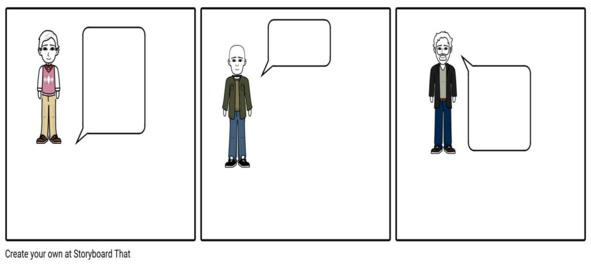
Полная версия
Английский для военных/Military English. Метод кейсов/Cases. Решения, ответы, словарь, глоссарий
while a more hostile operating environment or more expansive
missions required significantly more troops.
Actual WMD-E operations are likely to be far more challenging.
You can read the full version


CASE 2
Practical Speaking Training. Сrush the fear of public speaking
1. DRAW A CARTOON (Naval Admiral William McRaven`s addresses.)

https://youtu.be/pxBQLFLei70
What 1 lesson from this speech can you apply to your own life?
Directions:
Use the narrator’s descriptions to help you draw three Scenes and the characters.
– After you draw each scene, write what the characters talked or thought about.
– If the characters talk to each other, write their conversation in a speech bubble.
– Write a character’s thoughts about anything in a thought bubble.
Example: «If you want to change the world get over being a sugar cookie and keep moving forward.»
«There were many a student who just couldn’t accept the fact that all their effort was in vain… Those students didn’ t under-stand the purpose of the drill. You were never going to suc-ceed. You were never going to have a perfect uniform.»


As you brainstorm the story`s characters, think about which are their main
motivations. Which are their secondary ones?

Create your Speech.
The goal of this presentation is to show you how a speech success isn’t the re-sult of good luck, ability.
The speech success is simply a case of taking the steps required to introduce changes and bring revolution in every field, inspiration from your speech. How big your heart is.
Do you agree?
What were some of the main messages of this particular speech?
List the main points and themes.
– Oratory – What words or phrases helped to support the speech’s main pur-poses? In particular, which words or phrases evoked emotion, painted a strong image or are very descriptive. How do the words and phrases you’ve pointed out lend to (or distract from) the points being made?
– Emotion – What emotions do you believe Naval Admiral William McRaven was trying to evoke? Do you believe this was achieved? If so, what words in particular helped to convey emotion?
– Audience – To whom is Naval Admiral William McRaven trying to appeal? What words help you come to this conclusion?
– Delivery – What do you notice about Naval Admiral William McRaven `s use of elements like tone of voice, inflection, pause, pacing, rising and falling volume and body language to emphasize specific points in the speech?
There are many issues you can talk about at your inauguration. How do you pick one? A good idea is to look inside yourself and find out what you feel very deeply about. Maybe it’s the environment. Or you feel that downloading music on the Internet should be free. Your issue should reflect who you are and what you care about.

DRAW A CARTOON
1. Establish your character by asking each other
«wh’ questions (who, what, when, where, why and how). You should then discuss any points that they think are im-portant to support your point of view.
2 Storyboard Creator makes amazing visuals and graphic
https://www.storyboardthat.com/
– Organizers for digital storytelling.
– The role play can begin.
You have a maximum of three minutes to present your story.
– After the role-play is finished, an issue.
– Making notes will help you to remember the important points.
Example:

Write your speech.
– Keeping it simple
1. Write Like You Talk
Remember that you’re writing a speech, not an essay.
People will hear the speech, not read it.
– Use short sentences. It’s better to write two simple sentences than one long, complicated sentence.
– Use contractions. Say «I’m» instead of «I am» «we’re» in-stead of «we are.»
– Don’t use big words that you wouldn’t use when talk-ing to someone.
– You don’t have to follow all the rules of written English grammar.
«Like this. See? Got it? Hope so.»
– Always read your speech aloud while you’re writing it.
You’ll hear right away if you sound like a book or a real person talking!
– Use Concrete Words and Examples
Concrete details keep people interested. For instance, which is more effective? A vague sentence like «Open play spaces for children’s sports are in short supply.» Or the more concrete «We need more baseball and soccer fields for our kids.»
– Get Your Facts Together
You want people to believe that you know what you’re talking about!
So you’ll need to do some research.
For instance, let’s say your big issue is the environment. You promise to pass a law that says all new cars must run on electricity, not gas. That will cut down on air pollution! But it would help if you had a few facts:
How much bad air does one car create each year? How many new cars are sold in the world every year? So how much will pollution be cut every year?
Use the library or the Internet to do research. Your new policy proposal will sound really strong if you have the facts to back it up.
5. Persuade With a Classic Structure
In a speech where you’re trying to persuade someone, the classic structure is called «Problem-Solution.» In the first part of your speech you say, «Here’s a problem, here’s why things are so terrible.» Then, in the second part of your speech you say, «Here’s what we can do to make things better.» Sometimes it helps to persuade people if you have statistics or other facts in your speech. And sometimes you can persuade people by quoting some-one else that the audience likes and respects.
6. Simplify
After you’ve written a first draft of your speech, go back and look for words you can cut.
«Fewer Words = Clearer Point.» It helps her remember to always simplify a speech by cutting out words.

Exam
People make decisions based on what they see and hear.

Body language – make sure that you have a proper posture. If your shoulders are sagging and your legs are crossed, you will not appear as being sincere and people just will not ac-cept your message.
– Clothing. Talk about an outfit that inspires confidence, trust and strength.
– Articulation – articulation means how their total vocal process works.
– Pronunciation – you need to pronounce each word.
– Pitch – pitch refers to the highs and lows of the voice.
– Speed – the speed, or pace, is an important variable
to control. Between 140—160 words per minute is the nor-mal pace for a persuasive speech.
– Pauses – the pause, or caesura, is a critical persuasive tool. When they want to emphasize a certain word, have them just pause for one second before; this highlights the word.
– Volume – volume is another good tool for a persua-sive speech.
– Quality – quality of voice is gauged by the overall impact that their voice has on their listeners.
– Use of notes.
– Know 100 Words For Every Word That You Speak.
– Record Yourself And Learn Your Voice
Record your speech on your phone or video camera. end.
– Then listen to it or watch it, and make notes on how you could make it better. Some people do not like listen-ing to the sound of their voice on tape, so it is important that you get used to your own voice and speaking style.
– Try to eliminate all of your fears of rejection. The audience is there to listen to you for a reason.
Focus On The Material, Not The Audience.. Re-member that there will always be people who are bored or tired. None of these audience reac-tions have anything to do with you personally.
– Your strongest critic is you. When you finish a speech or delivering a presentation, give yourself a pat on the back.
– You overcame your fears and you did it.
Have pride in yourself.
In 2014, Naval Admiral William McRaven gave one of the most motivational and inspiring commencement addresses. Filled with personal experiences and timeless advice, and after 37 years of military service, I consider this advice worth taking. Admiral McRaven lays out the 10 life lessons from his experience as a Navy SEAL that can be applied to all areas of our life.
Speech Transcript
President Powers, Provost Fenves, Deans, members of the faculty, family and friends and most importantly, the class of 2014. Congratulations on your achieve-ment.
It’s been almost 37 years to the day that I graduated from UT. I remember a lot of things about that day. I remember I had throbbing headache from a party the night before. I remember I had a serious girlfriend, whom I later married – that’s important to remember by the way – and I remember that I was getting commissioned in the Navy that day.
But of all the things I remember, I don’t have a clue who the commencement speaker was that evening, and I certainly don’t remember anything they said. So, acknowledg-ing that fact, if I can’t make this commencement speech memorable, I will at least try to make it short.
The University’s slogan is, «What starts here changes the world.» I have to admit – I kinda like it. «What starts here changes the world.»
Tonight there are almost 8,000 students graduating from UT. That great paragon of analytical rigor, Ask.Com, says that the average American will meet 10,000 people in their lifetime. That’s a lot of folks. But, if every one of you changed the lives of just 10 people – and each one of those folks changed the lives of another 10 people – just 10 – then in five generations – 125 years – the class of 2014 will have changed the lives of 800 million people.
800 million people – think of it – over twice the population of the United States. Go one more generation and you can change the entire population of the world – eight billion people.
If you think it’s hard to change the lives of 10 people – change their lives forever – you’re wrong. I saw it happen every day in Iraq and Afghanistan: A young Army offi-cer makes a decision to go left instead of right down a road in Baghdad and the 10 soldiers in his squad are saved from close-in ambush. In Kandahar province, Afgha-nistan, a non-commissioned officer from the Female Engagement Team senses something isn’t right and directs the infantry platoon away from a 500-pound IED, saving the lives of a dozen soldiers.
But, if you think about it, not only were these soldiers saved by the decisions of one person, but their children yet unborn were also saved. And their children’s children were saved. Generations were saved by one decision, by one person.
But changing the world can happen anywhere and anyone can do it. So, what starts here can indeed change the world, but the question is – what will the world look like after you change it?
Well, I am confident that it will look much, much better. But if you will humor this old sailor for just a moment, I have a few suggestions that may help you on your way to a better a world. And while these lessons were learned during my time in the military, I can assure you that it matters not whether you ever served a day in uniform. It mat-ters not your gender, your ethnic or religious background, your orientation or your so-cial status.
Our struggles in this world are similar, and the lessons to overcome those struggles and to move forward – changing ourselves and the world around us – will apply equally to all.
I have been a Navy SEAL for 36 years. But it all began when I left UT for Basic SEAL training in Coronado, California. Basic SEAL training is six months of long torturous runs in the soft sand, midnight swims in the cold water off San Diego, obstacles courses, unending calisthenics, days without sleep and always being cold, wet and miserable. It is six months of being constantly harrassed by professionally trained warriors who seek to find the weak of mind and body and eliminate them from ever becoming a Navy SEAL.
But, the training also seeks to find those students who can lead in an environment of constant stress, chaos, failure and hardships. To me basic SEAL training was a life-time of challenges crammed into six months.
So, here are the 10 lessons I learned from basic SEAL training that hopefully will be of value to you as you move forward in life.
Every morning in basic SEAL training, my instructors, who at the time were all Viet-nam veterans, would show up in my barracks room and the first thing they would in-spect was your bed. If you did it right, the corners would be square, the covers pulled tight, the pillow centered just under the headboard and the extra blanket folded neatly at the foot of the rack – that’s Navy talk for bed.
It was a simple task – mundane at best. But every morning we were required to make our bed to perfection. It seemed a little ridiculous at the time, particularly in light of the fact that were aspiring to be real warriors, tough battle-hardened SEALs, but the wisdom of this simple act has been proven to me many times over.
If you make your bed every morning you will have accomplished the first task of the day. It will give you a small sense of pride, and it will encourage you to do another task and another and another. By the end of the day, that one task completed will have turned into many tasks completed. Making your bed will also reinforce the fact that little things in life matter. If you can’t do the little things right, you will never do the big things right.
And, if by chance you have a miserable day, you will come home to a bed that is made – that you made – and a made bed gives you encouragement that tomorrow will be better.
If you want to change the world, start off by making your bed.
During SEAL training the students are broken down into boat crews. Each crew is seven students – three on each side of a small rubber boat and one coxswain to help guide the dingy. Every day your boat crew forms up on the beach and is instruct-ed to get through the surfzone and paddle several miles down the coast. In the win-ter, the surf off San Diego can get to be 8 to 10 feet high and it is exceedingly difficult to paddle through the plunging surf unless everyone digs in. Every paddle must be synchronized to the stroke count of the coxswain. Everyone must exert equal effort or the boat will turn against the wave and be unceremoniously tossed back on the beach.
For the boat to make it to its destination, everyone must paddle. You can’t change the world alone – you will need some help – and to truly get from your starting point to your destination takes friends, colleagues, the good will of strangers and a strong coxswain to guide them.
If you want to change the world, find someone to help you paddle.
Over a few weeks of difficult training my SEAL class, which started with 150 men, was down to just 35. There were now six boat crews of seven men each. I was in the boat with the tall guys, but the best boat crew we had was made up of the the little guys – the munchkin crew we called them – no one was over about five-foot-five.
The munchkin boat crew had one American Indian, one African American, one Polish American, one Greek American, one Italian American, and two tough kids from the midwest. They out-paddled, out-ran and out-swam all the other boat crews. The big men in the other boat crews would always make good-natured fun of the tiny little flip-pers the munchkins put on their tiny little feet prior to every swim. But somehow these little guys, from every corner of the nation and the world, always had the last laugh – swimming faster than everyone and reaching the shore long before the rest of us.
SEAL training was a great equalizer. Nothing mattered but your will to succeed. Not your color, not your ethnic background, not your education and not your social status.
If you want to change the world, measure a person by the size of their heart, not the size of their flippers.
Several times a week, the instructors would line up the class and do a uniform in-spection. It was exceptionally thorough. Your hat had to be perfectly starched, your uniform immaculately pressed and your belt buckle shiny and void of any smudges. But it seemed that no matter how much effort you put into starching your hat, or pressing your uniform or polishing your belt buckle – it just wasn’t good enough. The instructors would find «something» wrong.
For failing the uniform inspection, the student had to run, fully clothed into the surf-zone and then, wet from head to toe, roll around on the beach until every part of your body was covered with sand. The effect was known as a «sugar cookie.» You stayed in that uniform the rest of the day – cold, wet and sandy.
There were many a student who just couldn’t accept the fact that all their effort was in vain. That no matter how hard they tried to get the uniform right, it was unappreciat-ed. Those students didn’t make it through training. Those students didn’t understand the purpose of the drill. You were never going to succeed. You were never going to have a perfect uniform.
Sometimes no matter how well you prepare or how well you perform you still end up as a sugar cookie. It’s just the way life is sometimes.
If you want to change the world get over being a sugar cookie and keep moving for-ward.
Every day during training you were challenged with multiple physical events – long runs, long swims, obstacle courses, hours of calisthenics – something designed to test your mettle. Every event had standards – times you had to meet. If you failed to meet those standards your name was posted on a list, and at the end of the day those on the list were invited to a «circus.» A circus was two hours of additional calis-thenics designed to wear you down, to break your spirit, to force you to quit.
No one wanted a circus.
A circus meant that for that day you didn’t measure up. A circus meant more fatigue
– and more fatigue meant that the following day would be more difficult – and more circuses were likely. But at some time during SEAL training, everyone – everyone – made the circus list.
But an interesting thing happened to those who were constantly on the list. Over time those students – who did two hours of extra calisthenics – got stronger and stron-ger. The pain of the circuses built inner strength, built physical resiliency.
Life is filled with circuses. You will fail. You will likely fail often. It will be painful. It will be discouraging. At times it will test you to your very core.
But if you want to change the world, don’t be afraid of the circuses.
At least twice a week, the trainees were required to run the obstacle course. The ob-stacle course contained 25 obstacles including a 10-foot high wall, a 30-foot cargo net and a barbed wire crawl, to name a few. But the most challenging obstacle was the slide for life. It had a three-level 30-foot tower at one end and a one-level tower at the other. In between was a 200-foot-long rope. You had to climb the three-tiered tower and once at the top, you grabbed the rope, swung underneath the rope and pulled yourself hand over hand until you got to the other end.
The record for the obstacle course had stood for years when my class began training in 1977. The record seemed unbeatable, until one day, a student decided to go down the slide for life head first. Instead of swinging his body underneath the rope and in-ching his way down, he bravely mounted the TOP of the rope and thrust himself for-ward.
It was a dangerous move – seemingly foolish, and fraught with risk. Failure could mean injury and being dropped from the training. Without hesitation the student slid down the rope perilously fast. Instead of several minutes, it only took him half that time and by the end of the course he had broken the record.
If you want to change the world sometimes you have to slide down the obstacle head first.
During the land warfare phase of training, the students are flown out to San Clemente Island which lies off the coast of San Diego. The waters off San Clemente are a breeding ground for the great white sharks. To pass SEAL training there are a series of long swims that must be completed. One is the night swim.
Before the swim the instructors joyfully brief the trainees on all the species of sharks that inhabit the waters off San Clemente. They assure you, however, that no student has ever been eaten by a shark – at least not recently. But, you are also taught that if a shark begins to circle your position – stand your ground. Do not swim away. Do not act afraid. And if the shark, hungry for a midnight snack, darts towards you – then summon up all your strength and punch him in the snout, and he will turn and swim away.
There are a lot of sharks in the world. If you hope to complete the swim you will have to deal with them.
So, if you want to change the world, don’t back down from the sharks.
As Navy SEALs one of our jobs is to conduct underwater attacks against enemy ship-ping. We practiced this technique extensively during basic training. The ship attack mission is where a pair of SEAL divers is dropped off outside an enemy harbor and then swims well over two miles – underwater – using nothing but a depth gauge and a compass to get to their target.
During the entire swim, even well below the surface, there is some light that comes through. It is comforting to know that there is open water above you. But as you ap-proach the ship, which is tied to a pier, the light begins to fade. The steel structure of the ship blocks the moonlight, it blocks the surrounding street lamps, it blocks all am-bient light.
To be successful in your mission, you have to swim under the ship and find the keel
– the centerline and the deepest part of the ship. This is your objective. But the keel is also the darkest part of the ship – where you cannot see your hand in front of your face, where the noise from the ship’s machinery is deafening and where it is easy to get disoriented and fail.
Every SEAL knows that under the keel, at the darkest moment of the mission, is the time when you must be calm, composed – when all your tactical skills, your physical power and all your inner strength must be brought to bear.


